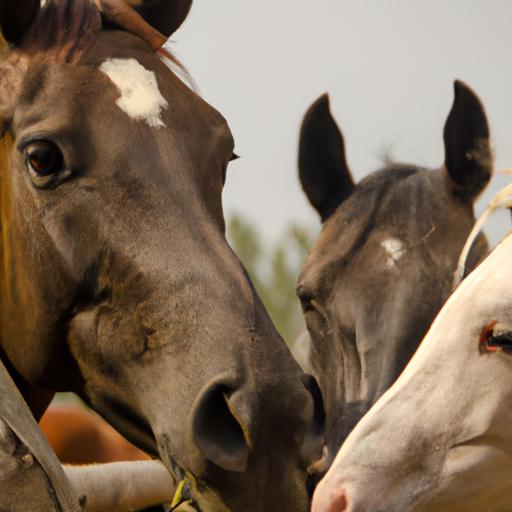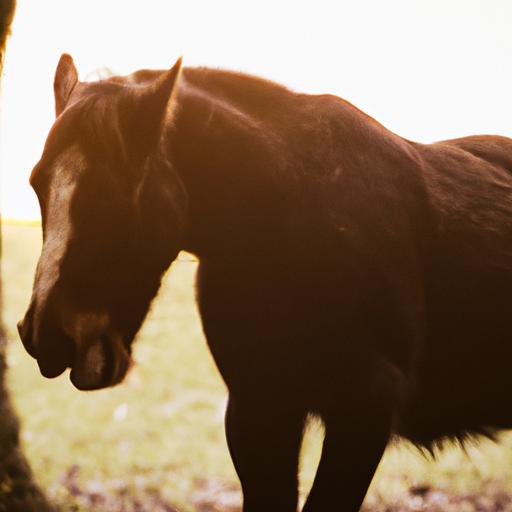Unlock the secrets of horse behavior with PDF resources. Gain easy access to comprehensive information and research studies. Enhance your equine understanding.
Introduction
Have you ever wondered what goes on inside the mind of a horse? Understanding horse behavior is not only fascinating but also crucial for anyone involved in working with these majestic creatures. By delving into the intricacies of equine psychology, we can build stronger bonds, improve training methods, and ensure the well-being of our equine companions. In this digital age, where knowledge is just a click away, PDF resources provide an invaluable tool for studying horse behavior.
The Significance of Horse Behavior
Horses, with their rich and complex behaviors, have captivated humans for centuries. From their social dynamics within a herd to their innate instincts, comprehending horse behavior offers insights into their needs, desires, and communication methods. By understanding equine psychology, we can interpret their body language, recognize signs of stress or discomfort, and adapt our interactions accordingly. Whether you’re an equestrian enthusiast, a trainer, or a horse owner, knowledge of horse behavior is indispensable for a harmonious partnership.
The Role of PDF Resources
In the quest to unravel the mysteries of horse behavior, the availability of reliable and comprehensive information is essential. This is where PDF resources prove to be an invaluable asset. PDFs, or Portable Document Format files, offer a convenient and accessible way to access a wealth of knowledge about horse behavior. They provide a platform for experts to share their research, experiences, and practical insights, empowering horse lovers with the tools they need to deepen their understanding.
PDF resources encompass a wide array of topics, ranging from the natural instincts and behaviors of horses to the impact of environmental factors on their well-being. These documents compile years of expertise, scientific studies, and real-life anecdotes, providing readers with a holistic view of horse behavior. Whether you’re seeking guidance on addressing common behavioral issues or wish to delve into the intricate dynamics of equine social structures, PDF resources offer a treasure trove of information at your fingertips.
As we embark on this exploration of horse behavior, let us embrace the power of PDF resources in unraveling the enigmatic world of equine psychology. By harnessing their potential, we can foster a deeper connection with our horses, uncovering the keys to their happiness and fulfillment. Join me on this captivating journey as we unlock the secrets of horse behavior together.
Stay tuned for Section II: Understanding Horse Behavior, where we delve into the natural instincts and behaviors of horses, shedding light on their captivating world.
Understanding Horse Behavior

Exploring the Natural Instincts and Behaviors of Horses
Horses are magnificent creatures with a rich tapestry of natural instincts and behaviors. To truly understand their behavior, we must embark on a journey into their world, exploring the innate qualities that make them unique. From their flight response, developed over thousands of years as prey animals, to their herd mentality, horses possess a complex set of instincts that shape their behavior.
At their core, horses are social animals, relying on the company of their herd for safety, companionship, and communication. Understanding their herd dynamics is crucial to comprehending their behavior. Within a herd, a hierarchy forms, with a dominant leader guiding the rest. This natural pecking order influences how horses interact, communicate, and establish their roles within the herd.
Examining the Social Dynamics within a Herd
Horses communicate through a subtle language of body cues, vocalizations, and gestures. The social dynamics within a herd involve intricate interactions and hierarchies based on dominance and submission. Observing these interactions provides valuable insights into their behavior.
Within a herd, dominant horses assert their authority through confident body language, such as holding their heads high and using assertive movements. Subordinate horses display deference by lowering their heads and adopting a more passive posture. These interactions help maintain order and minimize conflicts within the group.
Furthermore, understanding the social dynamics within a herd helps us interpret the behavior of individual horses. A horse’s position within the hierarchy influences their behavior, such as their confidence levels, willingness to cooperate, and response to training. Recognizing these dynamics enables us to tailor our approach, ensuring effective communication and a harmonious partnership with our equine companions.
By delving into the natural instincts and social dynamics of horses, we gain valuable insights into their behavior. This understanding forms the foundation for developing effective training techniques, addressing behavioral issues, and fostering a deep connection based on trust and mutual respect. Join me in Section III, where we explore the factors that influence horse behavior, shedding light on the impact of genetics and environmental factors.
Stay tuned for Section III: Factors Influencing Horse Behavior, where we delve into the role of genetics and environmental factors in shaping horse behavior.
Factors Influencing Horse Behavior
Role of Genetics and Breed Characteristics
When it comes to understanding horse behavior, it is essential to recognize the influence of genetics and breed characteristics. Just like humans, horses are born with certain traits and tendencies that are inherent to their breed. Different horse breeds have been selectively bred over generations, resulting in distinct behavioral patterns and temperaments.
For instance, Arabian horses are known for their high spirits and intelligence, while draft breeds, like the Clydesdales, exhibit a calm and gentle demeanor. Thoroughbreds, bred for racing, often possess a strong competitive drive. By understanding the breed-specific traits, we can better comprehend and work with each horse’s individual temperament.
Impact of Environmental Factors
While genetics play a significant role, it is equally important to consider the impact of environmental factors on horse behavior. The surroundings in which horses are raised and kept can shape their behavior and overall well-being.
Stabling conditions, for example, can significantly influence a horse’s behavior. A comfortable and spacious stable with proper ventilation promotes a sense of security and reduces stress levels. On the other hand, cramped or poorly maintained stables can lead to behavioral issues, such as cribbing or weaving.
Pasture conditions also play a vital role in horse behavior. Horses thrive when they have access to ample grazing areas and social interaction with other horses. Insufficient turnout time or limited socialization can result in boredom, restlessness, and even aggression. By providing horses with a natural and stimulating environment, we can encourage desirable behaviors and enhance their overall mental and physical well-being.
Understanding the interplay between genetics and environmental factors allows us to tailor our approach to each individual horse. By recognizing the unique combination of breed characteristics and the impact of their surroundings, we can create an environment that supports their natural behaviors and fosters a harmonious partnership.
Stay tuned for Section IV: Common Horse Behavior Issues, where we delve into the identification, causes, and solutions for common behavioral problems in horses.
Section IV: Common Horse Behavior Issues
Identifying and Understanding Behavioral Problems
Horses, much like humans, can sometimes exhibit behavioral issues that can pose challenges for their owners and handlers. It is essential to identify and address these problems to ensure the well-being and safety of both the horse and those around them. Let’s explore some common behavioral problems encountered in horses and gain insights into their underlying causes.
Biting: Unraveling the Motives
One prevalent issue that horse owners may encounter is biting. Why do horses engage in this behavior? Biting can stem from various motivations, including frustration, fear, or even seeking attention. Some horses resort to biting as a means of communication or when they feel threatened. Understanding the root cause of biting is crucial in developing effective strategies to address and prevent this behavior.
Kicking: Unveiling the Triggers
Another behavioral problem that can be hazardous to handlers and other animals is kicking. Horses may kick out of self-defense, pain, or as a reaction to discomfort. It is imperative to discern the triggers that provoke kicking, such as poor handling techniques, improper training, or underlying health issues. Identifying these triggers allows us to implement appropriate corrective measures and ensure the safety of all involved.
Cribbing: Seeking Solace in Unhealthy Habits
Cribbing, characterized by a horse grasping objects with its teeth and pulling back, can be a distressing behavior for both the horse and its owner. This stereotypic behavior often emerges from boredom, stress, or a lack of mental stimulation. While cribbing can lead to detrimental health consequences, it is essential to understand the underlying causes and provide alternative outlets for the horse’s energy and mental engagement.
Addressing Behavioral Issues: Finding Solutions
Once we have identified the root causes of common behavioral problems, it is crucial to explore potential solutions. Each behavior issue requires a tailored approach and a comprehensive understanding of the horse’s individual needs. Collaborating with equine professionals, such as trainers, veterinarians, or behaviorists, can provide valuable insights and guidance in formulating effective strategies.
Implementing positive reinforcement techniques, such as reward-based training, can help redirect unwanted behaviors and encourage desirable ones. Creating an enriching environment that stimulates the horse’s natural instincts and provides mental and physical engagement is also essential. Additionally, addressing any underlying health issues or discomfort can significantly contribute to resolving behavioral problems.
By investing time, patience, and expertise into understanding and addressing common behavioral issues, we can create a harmonious and fulfilling partnership with our horses. Remember, each horse is unique, and a compassionate and personalized approach is key to nurturing their well-being.
Stay tuned for Section V: Importance of PDF Resources in Studying Horse Behavior, where we explore the benefits of using PDF materials to deepen our knowledge of equine psychology.
Conclusion
In the realm of horse behavior, the power of knowledge knows no bounds. Through this article, we have embarked on a fascinating journey into the depths of equine psychology, understanding the significance of studying horse behavior and the invaluable role that PDF resources play in this pursuit.
By exploring the natural instincts and behaviors of horses, we gain insights into their world, allowing us to communicate effectively and establish a harmonious partnership. Understanding the factors that influence horse behavior, such as genetics and environmental conditions, empowers us to create optimal living environments and address behavioral issues with compassion and insight.
PDF resources emerge as the unsung heroes in our quest for knowledge. They provide a gateway to a vast array of information, offering easy access to comprehensive research studies, expert opinions, and practical insights. Whether you are a seasoned equestrian or a curious beginner, PDFs serve as invaluable tools for expanding your understanding of horse behavior.
By leveraging the benefits of PDF resources, we can enhance our horsemanship skills, deepen the human-horse bond, and ensure the well-being of our equine companions. These digital documents serve as a bridge between experts and enthusiasts, enabling us to tap into a wealth of wisdom and experience.
As we conclude our exploration into horse behavior, remember that the journey continues. Embrace the power of PDF resources and continue your quest for knowledge. Visit Horsemasterypro.com for a curated selection of recommended PDFs, carefully chosen to help you unravel the secrets of equine psychology.
Let us embark on this journey together, armed with the insights gained from studying horse behavior and the invaluable tools provided by PDF resources. Our equine partners deserve nothing less than our commitment to understanding them fully, and with PDFs in hand, we can unlock the true depths of their remarkable world.
Thank you for joining me on this captivating exploration of horse behavior. Until we meet again, may your adventures with horses be filled with understanding, harmony, and a deep connection.
References:
- “The Art of Horsemanship” by Xenophon
- “Understanding Horse Behavior” by Sue McDonnell
- “Equus Lost? How We Misunderstand the Nature of the Horse-Human Relationship” by Francesco De Giorgio and José De Giorgio-Schoorl


